 W
WAn automatic door, also known as an auto door, is a door that opens automatically, usually on sensing the approach of a person.
 W
WA door is a hinged or otherwise movable barrier that allows ingress into and egress from an enclosure. The created opening in the wall is a doorway or portal. A door's essential and primary purpose is to provide security by controlling access to the doorway (portal). Conventionally, it is a panel that fits into the portal of a building, room, or vehicle. Doors are generally made of a material suited to the door's task. Doors are commonly attached by hinges, but can move by other means, such as slides or counterbalancing.
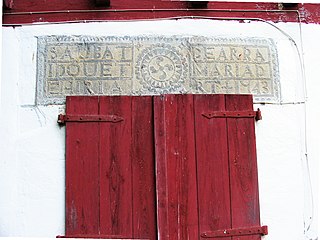 W
WAtalburu is the name given to the lintel above the main entrance of traditional Basque houses.
 W
WPlatform screen doors (PSDs), also known as platform edge doors (PEDs), are used at some train or subway stations to separate the platform from train tracks, as well as on some bus rapid transit systems. They are primarily used for passenger safety. They are a relatively new addition to many metro systems around the world, some having been retrofitted to established systems. They are widely used in Asian and European metro systems.
 W
WA bow visor is a feature of some ships, in particular ferries and roll-on/roll-off ships, that allows the bow to articulate up and down, providing access to the cargo ramp and storage deck near the water line. In modern ferry design over the last 25 years, though, bow visors have given way to clam doors. Instead of one large visor, two halves open horizontally to reveal the loading ramp and deck. These are believed to be safer than bow visor doors, as in a bow visor door, the forces acting on the door from the impact of the waves are absorbed by the hinges and locks, which may fail. With clam doors, the forces of the waves are absorbed by the surrounding bow superstructure. Furthermore, on seagoing vessels there should be inner bow doors or 'collision bulkhead doors' in place behind the loading ramp. These doors are an upper extension of the collision bulkhead and act as a secondary barrier against water entering the car deck, should the primary bow door(s) fail.
 W
WIn architecture and joinery, the chambranle is the border, frame, or ornament, made of stone or wood, that is a component of the three sides round chamber doors, large windows, and chimneys.
 W
WThe Close the Door campaign is a national campaign in the United Kingdom to encourage retailers to keep their doors closed to conserve energy and reduce carbon emissions.
 W
WA coal hole is a hatch in the pavement above an underground coal bunker. They are sometimes found outside houses that existed during the period when coal was widely used for domestic heating from the early 19th century to the middle 20th century. In Britain they became largely obsolete in major cities when the Clean Air Act of 1956 forced a move towards oil and gas for home heating.
 W
WA dead bolt, deadbolt or dead lock is a locking mechanism distinct from a spring bolt lock because a deadbolt cannot be moved to the open position except by rotating the key. The more common spring bolt lock uses a spring to hold the bolt in place, allowing retraction by applying force to the bolt itself. A deadbolt can therefore make a door more resistant to entry without the correct key, as well as make the door more resistant to forced entry.
 W
WDevil's doors are structural features found in the north wall of some medieval and older churches in the United Kingdom. They are particularly common in the historic county of Sussex, where more than 40 extant churches have one. They have their origins in the early Christian era, when pre-Christian worship was still popular, and were often merely symbolic structures—although they were sometimes used as genuine entrances.
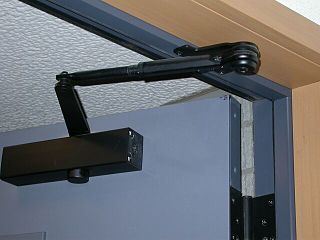 W
WDoor furniture or door hardware refers to any of the items that are attached to a door or a drawer to enhance its functionality or appearance.
 W
WA Dutch door, stable door, or half door, is a door divided in such a fashion that the bottom half may remain shut while the top half opens. They were known in early New England as a double-hung door. The initial purpose of this door design was to keep animals out of farmhouses or to keep children inside while allowing light and air to filter through the open top; essentially combining a door with a fairly large window. When the top half was open they also allowed a breeze, but stopped the wind from blowing dirt into the house. This type of door was common in the Netherlands in the seventeenth century and appears in Dutch paintings of the period. They were also commonly found in the Dutch cultural areas of New York and New Jersey before the American Revolution.
 W
WAn elevated entrance is a type of entrance, common in the design of medieval castles, that is not accessible from ground level, but lies at the level of an upper storey. The elevated entrance is the lowest and frequently the only way of entering a fortified building or residence. In the case of circular towers, a large opening in the main wall at ground level was a potential weakness and experts on castle design have argued that the elevated entrance served a structural as well as defensive purpose.
 W
WEmtek Products, Inc. is a door and cabinet hardware manufacturer, based in the City of Industry, Los Angeles County and a subsidiary of Swedish company Assa Abloy. The brand produces a range of residential lock products, including tubular locks, interior door knobs and levers, key locking hardware sets, electronic keyless locks, deadbolts, hinges, dutch door bolts and Mortise locks, and are represented by dealers and showrooms in the United States, Latin America and Canada. They also provide cabinet and drawer pulls for interior spaces like Kitchen cabinets and bathroom cabinets.
 W
WA fairy door is a miniature door, usually set into the base of a tree, behind which may be small spaces where people can leave notes, wishes, or gifts for the "fairies".
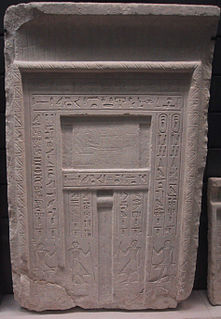 W
WA false door, or recessed niche, is an artistic representation of a door which does not function like a real door. They can be carved in a wall or painted on it. They are a common architectural element in the tombs of ancient Egypt, but appeared possibly earlier in some Pre-Nuragic Sardinian tombs. Later they also occur in Etruscan tombs and in the time of ancient Rome they were used in the interiors of both houses and tombs.
 W
WA fire door is a door with a fire-resistance rating used as part of a passive fire protection system to reduce the spread of fire and smoke between separate compartments of a structure and to enable safe egress from a building or structure or ship. In North American building codes, it, along with fire dampers, is often referred to as a closure, which can be derated compared against the fire separation that contains it, provided that this barrier is not a firewall or an occupancy separation. In Europe national standards for fire doors have been harmonised with the introduction of the new standard EN 16034, which refers to fire doors as fire-resisting door sets. Starting September 2016, a common CE marking procedure was available abolishing trade barriers within the European Union for these types of products. In the UK, it is Part B of the Building Regulations that sets out the minimum requirements for the fire protection that must be implemented in all dwellings this includes the use of fire doors. All fire doors must be installed with the appropriate fire resistant fittings, such as the frame and door hardware, for it to fully comply with any fire regulations.
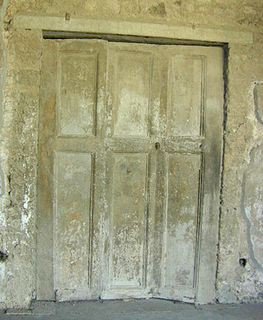 W
WA folding door is a type of door which opens by folding back in sections or so-called panels. Folding doors are also known as ‘bi-fold doors', in spite of them most often having more than two panels. Another term is ‘concertina’ doors, inspired by the musical instrument of the same name.
 W
WIn architecture, a frontispiece is the combination of elements that frame and decorate the main, or front, door to a building. The term is especially used when the main entrance is the chief face of the building rather than being kept behind columns or a portico. Early German churches often employed frontispieces to hide the aisles and nave. In Kentucky, the frontispieces of Georgian buildings characteristically feature a lunette above the door and colonettes on either side. In Chiapas, frontispieces are typically elongated.
 W
WIn Japanese architecture, fusuma (襖) are vertical rectangular panels which can slide from side to side to redefine spaces within a room, or act as doors. They typically measure about 90 centimetres (3.0 ft) wide by 180cm(5'11") tall, the same size as a tatami mat, and are two or three centimeters thick. The heights of fusuma have increased in recent years due to an increase in average height of the Japanese population, and a 190 centimetres (6.2 ft) height is now common. In older constructions, they are as small as 170 cm high. They consist of a lattice-like wooden understructure covered in cardboard and a layer of paper or cloth on both sides. They typically have a black lacquer border and a round finger catch.
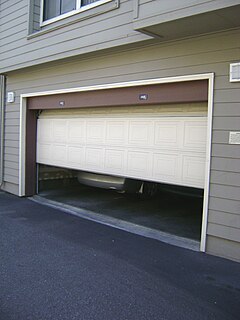 W
WA garage door is a large door on a garage that opens either manually or by an electric motor. Garage doors are frequently large enough to accommodate automobiles and other vehicles. Small garage doors may be made in a single panel that tilts up and back across the garage ceiling. Larger doors are usually made in several jointed panels that roll up on tracks across the garage ceiling, or into a roll above the doorway. The operating mechanism is spring-loaded or counterbalanced to offset the weight of the door and reduce the human or motor effort required to operate the door. Less commonly, some garage doors slide or swing horizontally. Doors are made of wood, metal, or fiberglass, and may be insulated to prevent heat loss. Warehouses, bus garages and locomotive sheds have larger versions.
 W
WA garage door opener is a motorized device that opens and closes garage doors controlled by switches on the garage wall. Most also include a handheld radio remote control carried by the owner, which can be used to open and close the door from a short distance.
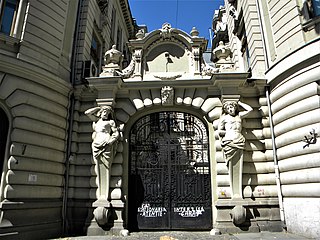 W
WA gate or gateway is a point of entry to a space which is enclosed by walls. Gates may prevent or control the entry or exit of individuals, or they may be merely decorative. Other terms for gate include yett and port. The word is derived from old Norse "gat", meaning road or path, and originally referred to the gap in the wall or fence, rather than the barrier which closed it. The moving part or parts of a gateway may be considered "doors", as they are fixed at one side whilst opening and closing like one.
 W
WHigh-speed doors are door systems, mainly used in industrial applications. They are technical enhancements of the generally known sectional doors, PVC fabric doors or roller shutters. The main difference is that the durable construction provides a higher operating speed and they are able to sustain a higher number of cycles and require lower maintenance and repair cost. Depending on the intended field of application, horizontal or vertical operating door types are available.
 W
WA Holy Door is traditionally an entrance portal located within the Papal major basilicas in Rome. The doors are normally sealed by mortar and cement from the inside so that they cannot be opened. They are ceremoniously opened during Jubilee years designated by the Pope, for pilgrims who enter through those doors may piously gain the plenary indulgences attached with the Jubilee year celebrations.
 W
WA jamb, in architecture, is the side-post or lining of a doorway or other aperture. The jambs of a window outside the frame are called “reveals.” Small shafts to doors and windows with caps and bases are known as “jamb-shafts”; when in the inside arris of the jamb of a window they are sometimes called "scoinsons."
 W
WA lintel or lintol is a structural horizontal block that spans the space or opening between two vertical supports. It can be a decorative architectural element, or a combined ornamented structural item. It is often found over portals, doors, windows and fireplaces. In the case of windows, the bottom span is instead referred to as a sill, but, unlike a lintel, does not serve to bear a load to ensure the integrity of the wall. Modern day lintels are made using prestressed concrete and are also referred to as beams in beam and block slabs or ribs in rib and block slabs. These prestressed concrete lintels and blocks are components that are packed together and propped to form a suspended floor concrete slab.
 W
WA lunette is a half-moon shaped architectural space, variously filled with sculpture, painted, glazed, filled with recessed masonry, or void. A lunette is formed when a horizontal cornice transects a round-headed arch at the level of the imposts, where the arch springs. If a door is set within a round-headed arch, the space within the arch above the door, masonry or glass, is a lunette. If the door is a major access, and the lunette above is massive and deeply set, it may be called a tympanum.
 W
WAn "overdoor" is a painting, bas-relief or decorative panel, generally in a horizontal format, that is set, typically within ornamental mouldings, over a door, or was originally intended for this purpose.
 W
WA sliding glass door, patio door, or doorwall is a type of sliding door in architecture and construction, is a large glass window opening in a structure that provide door access from a room to the outdoors, fresh air, and copious natural light. A sliding glass door is usually considered a single unit consisting of two panel sections, one being fixed and one a being mobile to slide open. Another design, a wall-sized glass pocket door has one or more panels movable and sliding into wall pockets, completely disappearing for a 'wide open' indoor-outdoor room experience.
 W
WPlatform screen doors (PSDs), also known as platform edge doors (PEDs), are used at some train or subway stations to separate the platform from train tracks, as well as on some bus rapid transit systems. They are primarily used for passenger safety. They are a relatively new addition to many metro systems around the world, some having been retrofitted to established systems. They are widely used in Asian and European metro systems.
 W
WA pocket door is a sliding door that, when fully open, disappears into a compartment in the adjacent wall. Pocket doors are used for architectural effect, or when there is no room for the swing of a hinged door. They can travel on rollers suspended from an overhead track or tracks or guides along the floor. Single- and double-door versions are used, depending on how wide an entry is desired.
 W
WA window is an opening in a wall, door, roof, or vehicle that allows the passage of light and may also allow the passage of sound and sometimes air. Modern windows are usually glazed or covered in some other transparent or translucent material, a sash set in a frame in the opening; the sash and frame are also referred to as a window. Many glazed windows may be opened, to allow ventilation, or closed, to exclude inclement weather. Windows may have a latch or similar mechanism to lock the window shut or to hold it open by various amounts.
 W
WA portal is an opening in a wall of a building, gate or fortification, especially a grand entrance to an important structure. Doors, metal gates, or portcullis in the opening can be used to control entry or exit. The surface surrounding the opening may be made of simple building materials or decorated with ornamentation. The elements of a portal can include the voussoir, tympanum, an ornamented mullion or trumeau between doors, and columns with carvings of saints in the westwork of a church.
 W
WPorte Saint-Nicolas is an historic gate in the French village of Ervy-le-Châtel, in the department of Aube.
 W
WIn architecture, post and lintel is a building system where strong horizontal elements are held up by strong vertical elements with large spaces between them. This is usually used to hold up a roof, creating a largely open space beneath, for whatever use the building is designed. The horizontal elements are called by a variety of names including lintel, header, architrave or beam, and the supporting vertical elements may be called columns, pillars, or posts. The use of wider elements at the top of the post, called capitals, to help spread the load, is common to many traditions.
 W
WA revolving door typically consists of three or four doors that hang on a central shaft and rotate around a vertical axis within a cylindrical enclosure. Revolving doors are energy efficient as they prevent drafts, thus decreasing the loss of heating or cooling for the building. Revolving doors were designed to relieve stack effect pressure in buildings. High-rise buildings experience immense pressure caused by air rushing through the building, referred to as 'Stack Effect' pressure. At the same time, revolving doors allow large numbers of people to pass in and out.
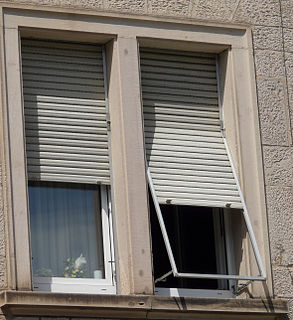 W
WA roller shutter, security shutter, coiling door, roller door or sectional overhead door is a type of door or window shutter consisting of many horizontal slats hinged together. The door is raised to open it and lowered to close it. On large doors, the action may be motorized. It provides protection against wind, rain, fire and theft. In shutter form, it is used in front of a window and protects the window from vandalism and burglary attempts.
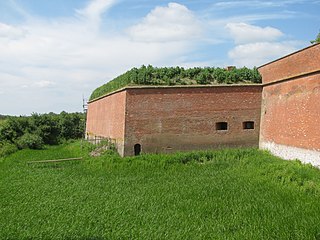 W
WA sally port is a secure, controlled entry way to an enclosure, e.g., a fortification or prison. The entrance is usually protected by some means, such as a fixed wall on the outside, parallel to the door, which must be circumvented to enter and prevents direct enemy fire from a distance. It may include two sets of doors that can be barred independently to further delay enemy penetration.
 W
WA screen door can refer to a hinged storm door or hinged screen door covering an exterior door, or a screened sliding door used with sliding glass doors. In any case, the screen door incorporates screen mesh to block birds, flying insects or airborne debris such as seeds or leaves from entering, and pets and small children from exiting interior spaces, while allowing for air, light, and views.
 W
WSecret passages, also commonly referred to as hidden passages or secret tunnels, are hidden routes used for stealthy travel, escape, or movement of people and goods. Such passageways are sometimes inside buildings leading to secret rooms. Others allow occupants to enter or exit buildings without being seen. Hidden passages and secret rooms have been built in castles and houses owned by heads of state, the wealthy, criminals, and abolitionists associated with the American Underground Railroad. These passages have helped besieged rulers to escape from their attackers, including Pope Alexander VI in 1494, Pope Clement VII in 1527 and Marie Antoinette in 1789. Passages and tunnels have been used by criminals, armies and political organizations to smuggle goods and people or conceal their activities.
 W
WA shōji is a door, window or room divider used in traditional Japanese architecture, consisting of translucent sheets on a lattice frame. Where light transmission is not needed, the similar but opaque fusuma is used. Shoji usually slide, but may occasionally be hung or hinged, especially in more rustic styles.
 W
WA sliding door is a type of door which opens horizontally by sliding, usually parallel to a wall. Sliding doors can be mounted either on top of a track below or be suspended from a track above and some types 'disappear' in a wall when slid open. There are several types of sliding doors such as pocket doors, Arcadia doors, and bypass doors. Sliding doors are commonly used as shower doors, glass doors, screen doors, wardrobe doors or in vans.
 W
WA sliding door operator is a device that operates a sliding door for pedestrian use. It opens the door automatically, waits, then closes it.
 W
WA sliding glass door, patio door, or doorwall is a type of sliding door in architecture and construction, is a large glass window opening in a structure that provide door access from a room to the outdoors, fresh air, and copious natural light. A sliding glass door is usually considered a single unit consisting of two panel sections, one being fixed and one a being mobile to slide open. Another design, a wall-sized glass pocket door has one or more panels movable and sliding into wall pockets, completely disappearing for a 'wide open' indoor-outdoor room experience.
 W
WA storm door is a type of door that is installed in front of an exterior access door to protect it from bad weather and allow ventilation. Storm doors generally have interchangeable glass panels and window screen panels to provide visibility and prevent flying insects from entering the home.
 W
WA threshold is the sill of a door. Some cultures attach special symbolism to a threshold. It is called a door saddle in British English and in New England.
 W
WThe trapdoor is a sliding or hinged door in the floor or ceiling. It is traditionally small in size. It was invented to facilitate the hoisting of grain up through mills, however, its list of uses has grown over time. The trapdoor has played a pivotal function in the operation of the gallows, cargo ships, trains and more recently theatre and films.
 W
WA wicket gate, or simply a wicket, is a pedestrian door or gate, particularly one built into a larger door or into a wall or fence.